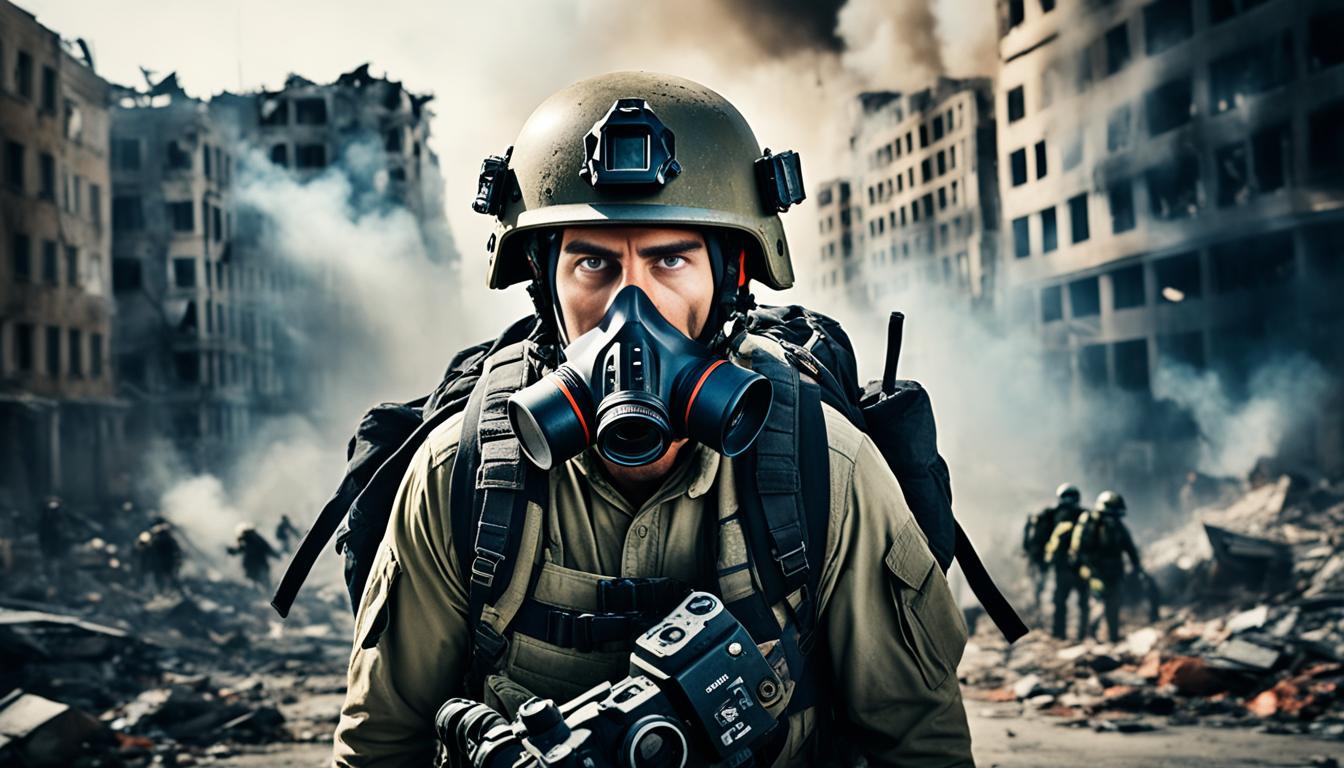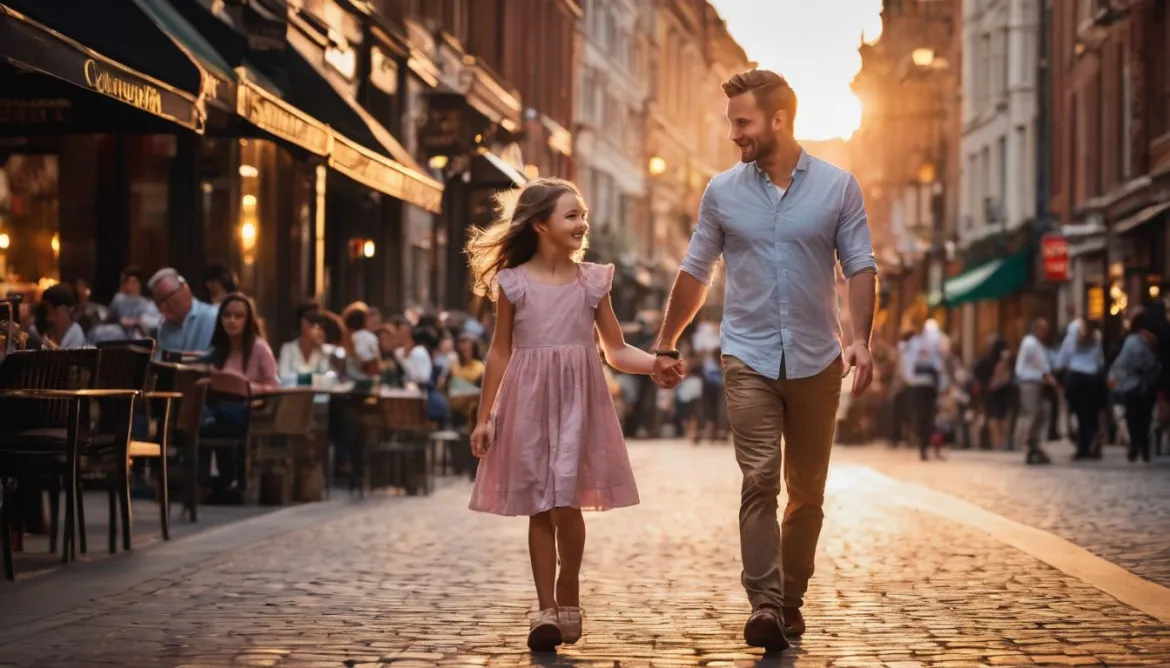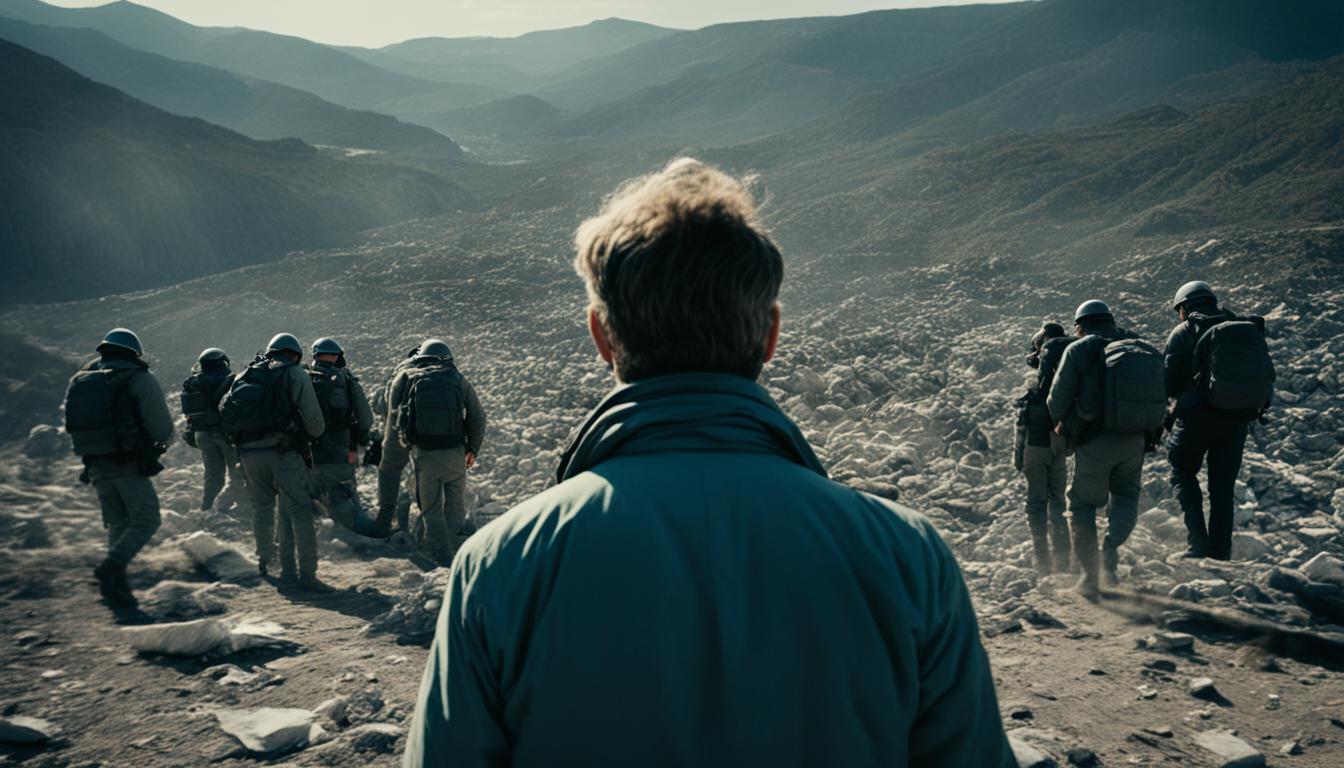War photography is a powerful medium that documents the realities of conflict zones, revealing the untold stories of those affected by war. It serves as a crucial tool in shaping public opinion, influencing political decisions, and shedding light on human suffering. However, war photographers face the ethical dilemma of balancing their duty to document with their responsibility to protect those they photograph.
Key Takeaways:
- War photography captures the raw emotions, devastation, and human suffering in conflict zones.
- It humanizes the victims, putting faces to statistics, and evokes empathy from viewers.
- Photographers must navigate the delicate balance between capturing powerful images and ensuring the well-being of those they encounter.
- War photographers face challenges such as physical danger, emotional toll, access restrictions, and equipment limitations.
- Resilience and hope are emphasized through war photography, reminding us of the indomitable human spirit.
The Power of War Photography in Conflict Zones
War photography is a powerful medium for capturing the harsh realities of conflict zones and conveying them to the world. These images have the ability to transport viewers to the frontlines, immersing them in the chaos and devastation that follows bombings and military operations. In this visual narrative, war photographers document the anguish of civilians, the aftermath of destruction, and the resilience of individuals amidst unimaginable circumstances.
Through their lens, war photographers humanize the victims of war, putting faces to statistics and evoking empathy from viewers. These photographs serve as a historical record, showcasing the stories of those affected by conflict and becoming a visual testament to the atrocities witnessed. They play a significant role in shaping public opinion and policy, compelling individuals and governments to confront the harsh realities of war and take action.
War photography provides a voice to the voiceless and sheds light on the untold stories of those living in conflict zones. It has the power to change public opinion, evoke compassion, and ultimately contribute to positive change.
By capturing the true essence of conflict zones, war photographers create a visual narrative that showcases both the immediate impact and long-term consequences of war. Their images bring to light the human suffering and resilience amidst unimaginable circumstances, challenging viewers to confront their preconceived notions and understand the true cost of war.
The Role of War Photography in Shaping Public Opinion
War photography plays a significant role in shaping public opinion on conflicts around the world. Through the power of visual storytelling, these images provide an intimate view into the lives of those affected by war, fostering empathy, and driving individuals to take action.
These photographs also serve as a catalyst for change, influencing political decisions and policies. The emotional impact of war photography can ignite public outrage, leading to increased pressure on governments and international organizations to intervene and provide aid to conflict-affected regions. As such, war photographers become agents of change, using their craft to expose the realities of war and compel individuals and societies to take a stand against injustice.
The Historical Significance of War Photography
War photography has immense historical significance, documenting events that may otherwise be forgotten or distorted by time. These powerful images capture moments of human triumph, tragedy, and resilience, leaving a lasting impact on societies and future generations.
They serve as a visual archive, allowing us to revisit past conflicts and learn from the mistakes and triumphs of the past. Without war photography, our understanding of past conflicts would be solely reliant on written accounts and secondhand narratives. Through their visual documentation, war photographers become chroniclers of history, ensuring that the stories of those affected by war are not forgotten.
Balancing the Duty to Document with the Responsibility to Protect
As war photographers, we possess a deep sense of duty to capture and preserve the truth. Our photographs document the atrocities, human rights abuses, and war crimes that unfold in front of our lenses. However, we also recognize our responsibility to protect the individuals we photograph, respecting their privacy and preserving their dignity. This ethical dilemma poses a constant challenge as we navigate the complex landscape of conflict zones.
The duty to document implies courageously facing the harsh realities of war, allowing us to shine a light on the untold stories that would otherwise remain hidden. By capturing these images, we give a voice to those who have been silenced and expose the injustices that demand attention. Our photographs become a historical record and a call to action, compelling viewers to confront the harsh realities of conflict.
Simultaneously, we shoulder the responsibility to protect the individuals we encounter. This extends beyond physical safety to encompass their privacy and dignity. Our subjects are vulnerable, caught in the midst of violence and turmoil. As war photographers, we must navigate the fine line between capturing powerful images and ensuring the well-being of those we photograph.
Each situation demands careful consideration, as the perspectives on this ethical dilemma vary. Some prioritize capturing the truth, believing that documenting the harsh realities of war is of utmost importance. They argue that by shining a light on the darkest corners of conflict zones, we create awareness and facilitate positive change. Others emphasize the protection of vulnerable individuals and advocate for respecting their privacy and dignity, acknowledging that the repercussions of being exposed in such circumstances can be severe.
Ultimately, as war photographers, we must continually assess the impact of our work and the potential consequences for those we photograph. It is our ethical responsibility to approach each situation with sensitivity and empathy, finding a balance that respects both the duty to document and the responsibility to protect. Only through careful consideration and thoughtful decision-making can we navigate this ongoing ethical dilemma.
The Challenges and Risks Faced by War Photographers
War photographers brave numerous challenges and risks in their profession. They put their lives on the line by venturing into conflict zones, where they must navigate through constant danger and evade sniper fire. These courageous individuals endure extreme weather conditions, facing harsh environments that can include scorching heat, freezing temperatures, and torrential rain.
The emotional toll of witnessing the atrocities of war cannot be underestimated. War photographers are exposed to devastating scenes of violence, loss, and human suffering, which can have a profound impact on their mental well-being. Many experience post-traumatic stress disorder (PTSD) and other mental health issues as a result of their work, carrying the weight of these traumas with them long after they have left the battlefield.
Access restrictions are a significant challenge faced by war photographers. Conflict zones often have strict control on entry and movement, making it difficult for journalists to reach areas where critical events are unfolding. These restrictions can limit the scope of their work and hinder their ability to document the complete story. Additionally, equipment limitations pose further obstacles. In the chaos of conflict, photographers may face the challenge of capturing impactful images with limited resources, making it essential to adapt and make the most of available tools.
“War photography is a truly immersive and intense experience. It demands not only physical stamina but also emotional resilience. It is a constant battle between capturing the truth and protecting oneself and the subjects.”
Physical Danger and Perseverance
The physical danger faced by war photographers cannot be understated. They work in high-risk environments, where their safety is constantly at stake. Dodging bullets, avoiding explosions, and navigating through treacherous terrain are the harsh realities they confront. Despite these dangers, these brave individuals persist in documenting the stories that need to be told.
The Emotional Toll of Bearing Witness
Bearing witness to the horrors of war takes an immense emotional toll on war photographers. They are confronted with the plight of civilians caught in the crossfire, the grief of families torn apart, and the brutalities inflicted upon innocent lives. The emotional weight of these experiences can lead to long-term psychological consequences, magnifying the importance of mental health support and self-care for those working in conflict zones.
Access Restrictions and Equipment Limitations
Access restrictions pose significant challenges for conflict photographers. These restrictions can be imposed by governments, armed groups, or the logistical difficulties of operating in war-torn areas. Limited access hinders the ability to capture a comprehensive and accurate picture of the conflict, leaving gaps in the narrative. Moreover, equipment limitations, such as limited battery life, low light performance, and the need to travel light, add further complexity to the already demanding task of documenting the realities of war.
Portraits of Resilience and Hope
War photography serves a profound purpose beyond capturing the horrors of war. It also aims to illuminate the resilience and hope that reside within the depths of the human spirit. Amidst the chaos and destruction of conflict zones, photographers strive to immortalize the indomitable strength and unwavering optimism of individuals facing unimaginable adversity.
In the midst of war’s unforgiving grip, these portraits of resilience and hope offer glimpses into the unwavering determination of individuals who refuse to surrender to despair.
Through their lens, war photographers immortalize the stories of those who must summon extraordinary courage and strength to endure. Every photograph becomes a testament to the human spirit’s unwavering resolve, reminding us that there is always reason to hope, even amid the darkest of circumstances.
War-torn statistics pale in comparison to the impact of these powerful images. They remind us that behind the cold numbers lie individuals with dreams, aspirations, and loved ones. The portraits of resilience and hope captured by war photographers compel us to confront our own humanity and reflect on the strength we might summon in the face of adversity.
Amid the chaos, destruction, and devastation, these portraits offer us a glimmer of light and a reminder that hope endures. They represent the unwavering human spirit that refuses to be extinguished, demonstrating that even in the darkest moments, there is always a sliver of hope pushing through.
“Photography for me is not looking, it’s feeling. If you can’t feel what you’re looking at, then you’re never going to get others to feel anything when they look at your pictures.” – Don McCullin, British photojournalist

These portraits evoke a profound sense of empathy while inspiring us to believe in the power of the human spirit. They remind us that amidst the chaos and violence, resilience and hope prevail.
The Role of Ethics in Conflict Photography
Ethics play a crucial role in the field of conflict photography. As photojournalists, we have a responsibility to document the truth and present it in a transparent and authentic manner. This requires us to adhere to strict ethical guidelines, ensuring that our photographs accurately depict the realities of conflict without manipulation or distortion.
One of the most important ethical considerations in conflict photography is the prohibition of photo manipulation in post-processing. This means that we must refrain from digitally altering images to enhance the drama or impact of a scene. Manipulating photographs not only compromises the integrity of the story we are trying to tell but also undermines the trust of our audience.
The implications of violating ethical standards in conflict photography can be severe. Pulitzer Prize-winning photographer, Steve McCurry, faced backlash and condemnation when it was discovered that he had manipulated an image. McCurry’s case serves as a stark reminder of the importance of maintaining ethical standards in our profession. It is a reminder that no matter the fame or recognition, the integrity of our work should always be our priority.
Preserving the authenticity of the image
By upholding ethical principles, we ensure that the photographs we capture accurately represent the realities of conflict. This authenticity is essential for fostering a true understanding of the events unfolding in these troubled regions. When our audience trusts that our photographs are genuine and unaltered, they are more likely to engage and respond to the issues and experiences of those affected by war.
“Integrity is the cornerstone of our profession. Maintaining ethical standards in conflict photography is crucial in gaining the trust and respect of our audience.”
The impact of digital ethics in journalism
In today’s digital age, the issue of ethics goes beyond photo manipulation to encompass a range of digital practices. The rapid spread of information online and the ease of digital editing have raised concerns about the integrity and authenticity of visual storytelling. As conflict photographers, we must navigate these challenges and ensure that our work remains true to the ethical standards that govern our profession.
Through ethical conduct, we contribute to the credibility and reliability of journalism as a whole. By displaying the realities of conflict through honest and unmanipulated imagery, we help to foster meaningful conversations and shape public opinion. It is through upholding ethical principles that we can stay true to our purpose as conflict photographers and provide the world with an accurate and unbiased visual record of history.
| Ethical Guidelines in Conflict Photography | Examples |
|---|---|
| Do not digitally manipulate images | |
| Obtain informed consent when photographing individuals | |
| Show respect for the privacy and dignity of subjects | |
| Avoid sensationalism and gratuitous violence |  |
By adhering to these ethical guidelines, we uphold the values of truth, integrity, and responsibility that are crucial to the practice of conflict photography. It is through these ethical foundations that we can create a lasting impact, evoke empathy, and contribute meaningfully to public discourse on the harsh realities of war.
Equipment and Safety Measures for War Photographers
War photographers navigate the dangers of conflict zones using specialized equipment and safety measures. To capture powerful images amidst harsh conditions, we rely on durable cameras and lenses that can withstand dust, sand, extreme temperatures, and humidity. These tools are essential for ensuring that we can effectively document the realities of conflict and share them with the world.
In addition to reliable equipment, protective gear plays a crucial role in ensuring our physical safety. War photographers often wear helmets and bulletproof vests to minimize the risks associated with operating in dangerous environments. By prioritizing our own protection, we can continue to gather vital visual evidence without compromising our well-being.
Collaboration with organizations that operate in conflict zones is also crucial. These partnerships allow us to access resources, receive important safety briefings, and benefit from the knowledge of experienced professionals. Adhering to strict safety protocols prescribed by these organizations further helps minimize the risks associated with our work.
As war photographers, we understand the vital importance of using reliable equipment, wearing appropriate protective gear, and following safety measures. By prioritizing our own safety, we can continue to document the realities of conflict and contribute to the understanding and resolution of global conflicts.
Essential Equipment for War Photographers:
- Durable cameras and lenses capable of withstanding harsh conditions
- Sturdy tripods and monopods for stability during intense situations
- Memory cards and backup storage to ensure the preservation of images
- Batteries and chargers to maintain power supply in remote areas
Protective Gear for War Photographers:
- Helmets to protect against head injuries
- Bulletproof vests to minimize the risks of gunshot wounds
- Knee and elbow pads for additional protection
- Gloves for hand protection and grip
Safety Measures for War Photographers:
- Collaboration with reputable organizations operating in conflict zones
- Adherence to strict safety protocols and guidelines
- Regular safety briefings and training sessions
- Clear communication systems to stay connected with the team
Conclusion
Navigating safety and ethics in conflict photography is a complex task that requires a delicate balance between the duty to document and the responsibility to protect. War photographers face numerous challenges and risks in their pursuit of capturing the realities of war. However, through their powerful images, they have the ability to convey not only the devastation but also the resilience and hope that exists amidst the chaos.
Adhering to ethical standards is crucial for responsible documentation and ethical storytelling in conflict photography. By prioritizing the well-being of those they photograph and maintaining integrity in their work, photographers can contribute to positive change and shed light on the untold stories of those affected by war.
Conflict photography serves as a visual narrative that has the power to shape public opinion and influence political decisions. By capturing the raw emotions and human suffering in conflict zones, photographers humanize the victims and evoke empathy from viewers. It is through these images that the world can better understand the realities of war and the urgent need for solutions.
In conclusion, ethical storytelling and responsible documentation are essential in conflict photography. By preserving the truth while safeguarding the safety, privacy, and dignity of those they photograph, war photographers can fulfill their duty to document while ensuring the well-being of the individuals they encounter. Through their work, they contribute to a greater understanding of conflict and inspire action towards a more peaceful world.
FAQ
What is the role of war photography in conflict zones?
War photography serves as a powerful tool in documenting the realities of conflict zones, capturing the raw emotions, devastation, and human suffering. It shapes public opinion, influences political decisions, and humanizes the victims of war.
How do war photographers balance their duty to document with the responsibility to protect?
War photographers face an ethical dilemma in navigating between their duty to capture and preserve the truth and their responsibility to protect the individuals they photograph. They must find a delicate balance between documenting powerful images and ensuring the safety, privacy, and dignity of those they encounter.
What are the challenges and risks faced by war photographers?
War photographers put their lives at risk in conflict zones, facing danger, sniper fire, and extreme weather conditions. Witnessing the atrocities of war takes an emotional toll, leading to mental health issues. Access restrictions and equipment limitations further complicate their work.
What message do war photographers aim to convey through their images?
War photographers not only capture the horrors of war but also highlight the resilience and hope found within the human spirit. Their images showcase the indomitable strength and unwavering hope of individuals amidst the chaos of conflict zones.
What role do ethics play in conflict photography?
Ethics are crucial in conflict photography, as photojournalists must adhere to strict guidelines, including not digitally manipulating images in post-processing. Violating these ethics can have severe consequences, such as termination from reputable news organizations.
What equipment and safety measures do war photographers rely on?
War photographers require durable cameras and lenses capable of withstanding harsh conditions like dust, extreme temperatures, and humidity. Protective gear, including helmets and bulletproof vests, is essential for their physical safety. Collaboration with organizations and adherence to safety protocols further minimize risks.
How Do Legal Considerations Impact Safety and Ethics in Conflict Photography?
Legal considerations in media play a crucial role in shaping the safety and ethics of conflict photography. Journalists must navigate a complex web of laws and regulations to ensure they are ethically and legally sound while capturing images in conflict zones. Understanding these legal considerations is vital to upholding integrity in the field.




